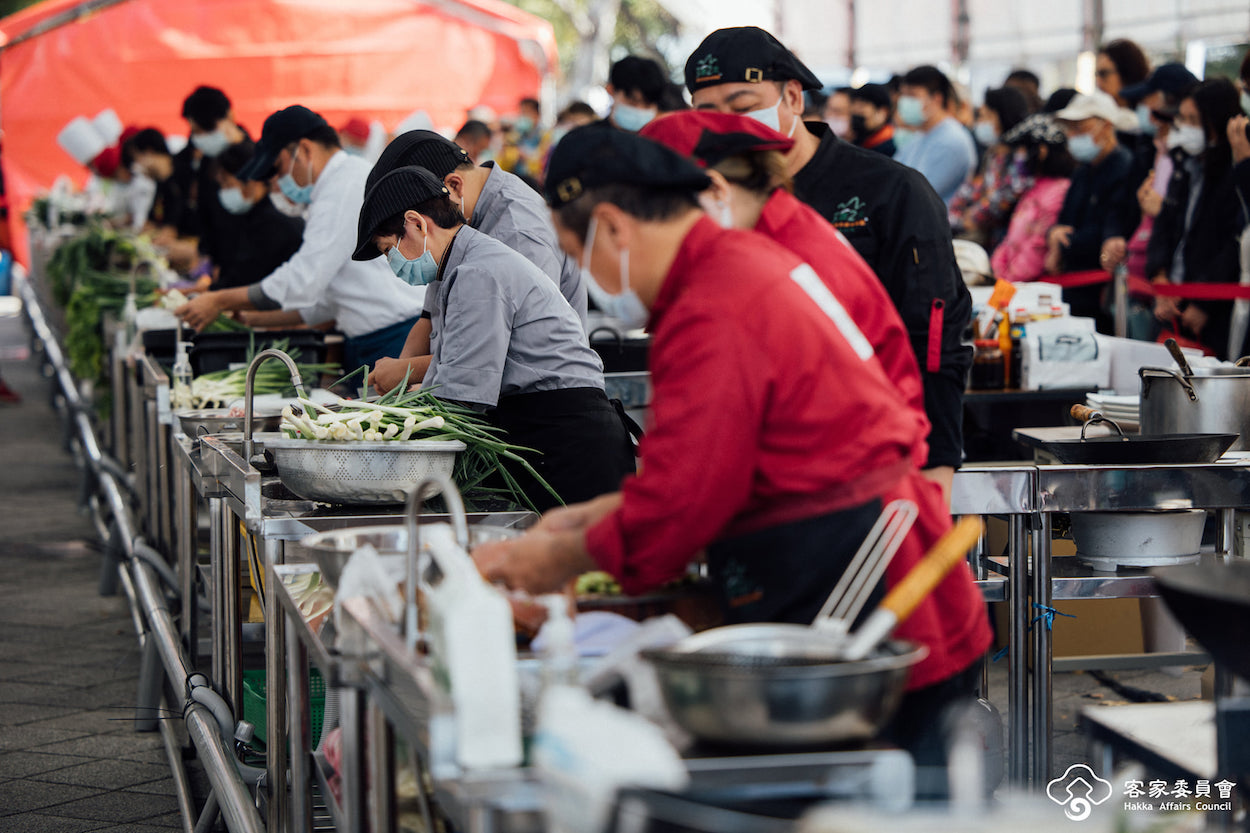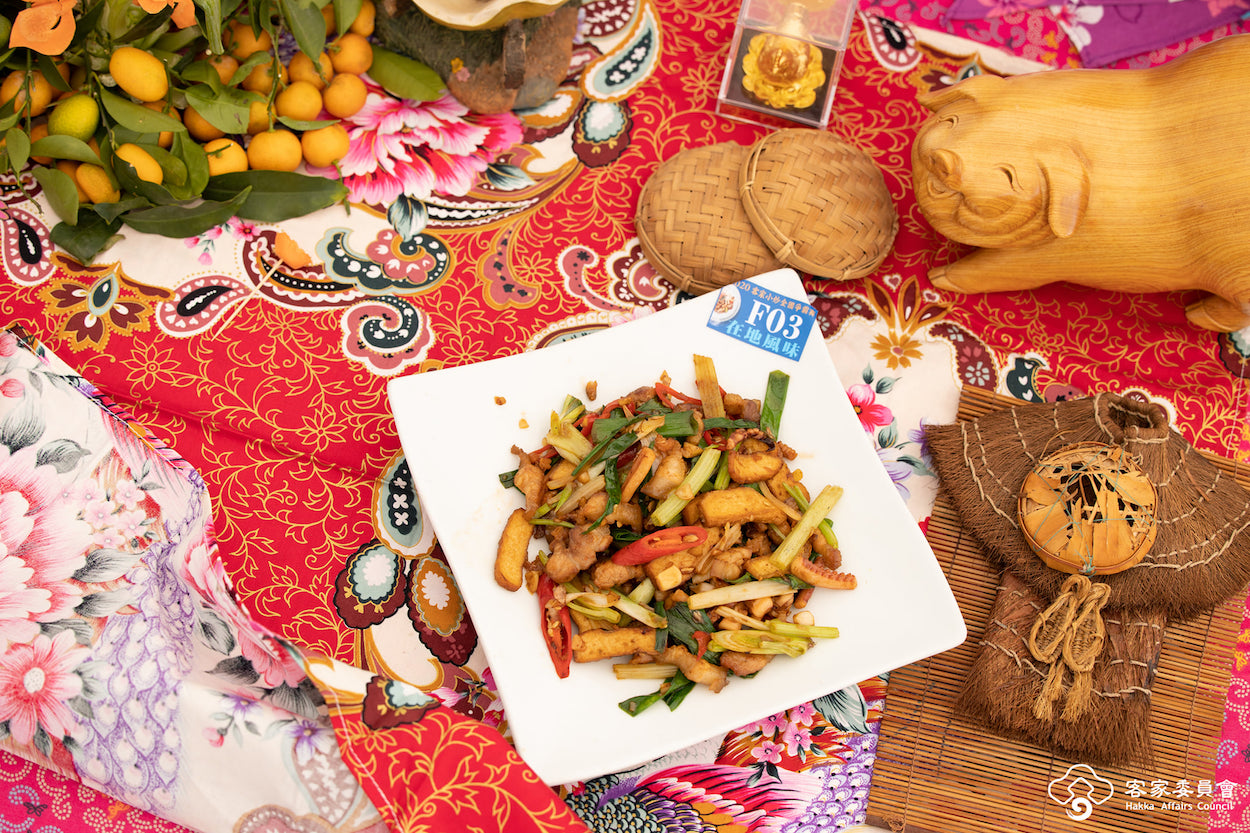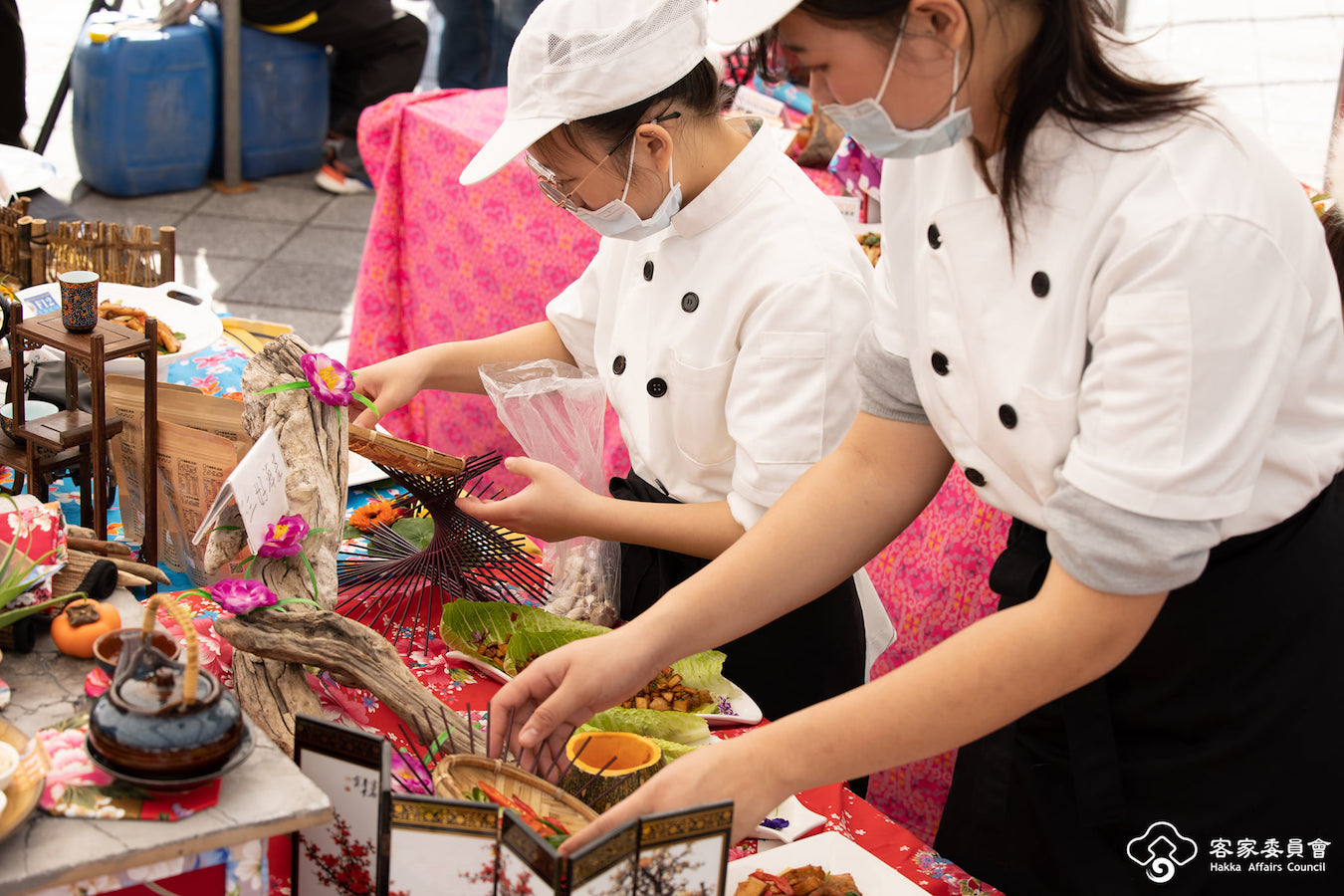by Susan Chang
語言:
English
Photo Credit: Hakka Affairs Council/Facebook
“THE WINNER of the 2020 National Hakka Stir-fry Culinary Competition goes to A-Wu’s Shop!”, announced Andre Chiang, the lead judge of the final round judges’ panel. The crowd cheered as the restaurant owner and chefs headed up to the stage to claim their trophy and banner. The event ended on a joyful account with the host gathering all winning teams for a photo, and crowds lining up in front of their favorite stalls before all the samples ran out. For those watching on national television, as well as on Hakka Affairs Council’s Facebook page, looking at images of ‘stir-fry’ is a torture, as one can almost smell and taste it from the other side of the screen.
This was the scene at the first-ever Hakka stir-fry competition held by the Hakka Affairs Council in Taiwan, which took place in Taipei on January 16th, 2021. The preliminary rounds were held separately at the north, central, south and east regions of the island starting from December 19th, 2020.

Photo credit: Hakka Affairs Council/Facebook
All eyes were on the cooking techniques and styles of top chefs around the country, with many hoping to eventually get a taste of either the signature dish, the small market stalls of traditional Hakka snacks, or Hakka culture-inspired creative products. Hands-on activities and folk dance performance added to the crowd’s sensorial and embodied experience.
Hakka (客家 or literally “Guest People”) is one ethnic group of the Han Chinese, and currently accounts for 20 percent of Taiwan’s population of 23 million. Hakka food culture is unique as it formed through multiple migrations within China and around the world. According to Yang , when migrating around China, Hakka people used to live in dire mountainous areas with poor soil. [1] Their food culture, therefore, reflects the Hakka’s traditional staple ingredients as “wild, coarse, and mixed” and the dishes as “savory, flavorsome, oily and strong”.
Hakka stir-fry, a traditional stir-fry dish made with dried squid, pork belly, celery and spring onions, prepared during religious festivals in the past, is the embodiment of this arduous journey from the north to Taiwan.

Photo credit: Hakka Affairs Council/Facebook
This fun and “tasty” competition provided a chance for people to learn about Hakka culture. “Stir-fry is one of the dishes that is the most culturally embedded,” said the Head of the Council Yiong Con-ziin. The other reason for hosting this competition is to raise awareness and drive business that is highly affected by the impact of COVID-19.
Additionally, the competition plays a crucial role in building social connections and reproducing heritage through sensorial elements. Nation-states routinely engaged in heritage-making to build national identity and a sense of nationhood. [2] The production of sensorial encounters bridge the gap between discourse of national history and personal memory. As Heatherington proposes, “Stories about the past become ‘true’ when we see, feel and hear their traces in the world around us and in ourselves”. [3] In this case, stir-fry may readily become a quotidian expression of belonging and identity.
Many, however, would point out that the notion of Hakka food as “savory, flavorsome, oily and strong” is a stereotype and a static understanding of what Hakka people eat. In one of the discussions I had with a Hakka friend, stir-fry is a must-order when we go to a Hakka cuisine restaurant but rarely something we have at home. She mentions that her parents prefer to boil food and make stews. According to my own memory, my mom has only recreated stir-fry less than five times and often complains about the oil fumes that don’t get vented out. One other reason she pointed out is that modern-day families rarely buy and keep dried squid and usually find pork belly unhealthy. Therefore, it can be said that the dishes served in Hakka restaurants are actually just specific dietary stereotypes of capitalist society. [4] In order to understand the characteristics of the modern Hakka diet, one needs to understand the social world and the way of cooking and using ingredients in today’s context. [5]
In this regard, the invitation of Andre Chiang shows that this competition has more ambition than evoking a sense of familiarity or triggering memories of home. Before returning to Taiwan, Chiang was the head chef of several Michelin star restaurants. He was the owner of Restaurant André, (before closing it down in 2018) which caused waves with the “Octo-philosophy”: Unique, Pure, Texture, Memory, Salt, South, Artisan, and Terroir.
In one of the National Hakka Stir-fry Culinary Competition promotions videos, Chiang spoke of what Hakka stir-fry and the Hakka Spirit means to him, “Every cuisine reflects its time…the characteristics of the Hakka stir-fry is that each ingredient has its own quality, and the entire dish is made up of the layers of the essences of these ingredients”. Combining fundamentals and techniques of French cuisine with Hakka cooking traditional and practices, his Hakka stir-fry is created using seven methods on the seven ingredients: sauté (squid), boil (spring onion and garlic), stir-fry (celery), deep-fry (tofu skin), stew (grounded beef), grill (chilly), and burn. The finishing product is in fact “layered” on a French plating.
Film credit: Hakka Affairs Council/Facebook
Unlike the traditional stir-fry that reflects the hardworking, frugal, tough and determined Hakka, fearless of dire situations, Chiang’s reinterpretation of Hakka Stir-fry offers novel ways of approaching Hakka food but at the same time retains the concomitant smell, sight, texture and tastes of the traditional dish. Chiang’s reinvention reminds us that while searching for stir-fry may be a sojourn of home for many far away from home, we, like our ancestors, are “Guest-People” on the move and that we create culture and tradition according to our various new “homes”.
Like Chiang’s stir-fry that breaks away from the limits of tradition but at the same time keeps true to its origins, Hakka and the Hakka spirit has gone a long way from being “merely” frugal and tough and finds happiness in contentment, and change in originality.
[1] Yang, Chao-Jing. 2003. See the practical spirit of Hakka food culture. Hakka Food Culture Series, 34-37. Taipei: Hakka Committee of the Executive Yuan. (楊昭景。2003。看見客家飲食文化的實用精神。客家飲食 文化輯,34-37。台北:行政院客家委員會。)
[2] Billig, M. 1995. Banal Nationalism. London: Sage Publications.
[3] Heatherington, T. 1999. Street tactics: Catholic ritual and the senses of the past in Central Sardinia. Ethnology, 38(4): 315-34.
[4] Chang et al. 2019. Thank You Hakka. Miaoli: Taiwan Hakka Cultural Development Center, Hakka Affairs Council. (張維安、謝世忠、劉瑞超。2019。承蒙:臺灣客家與客家臺灣。苗栗:客家委員會客家文化發展中心。)
[5] Chang, Wei-An. 2020. Hakka Culture and Hakka Cuisine (客家族群文化與客家菜). Inspiration Lab, NCTU. https://inspir.nctu.edu.tw/%E5%AE%A2%E5%AE%B6%E6%97%8F%E7%BE%A4%E6%96%87%E5%8C%96%E8%88%87%E5%AE%A2%E5%AE%B6%E8%8F%9C/
Hakka Affairs Council Facebook Page: https://www.facebook.com/www.hakka.gov.tw



